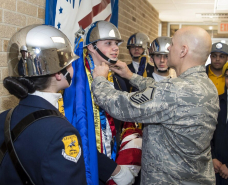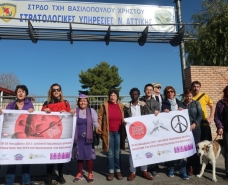DoD Starbase Militarizes Education for Disadvantaged Children in the USA

The U.S. Department of Defense recently released their 2014 DoD Starbase Annual Report covering this program's impact on 10 to 14 year old children in U.S. public schools. One of the Starbase organizers is Major General Lee Tafanelli, of the Kansas National Guard, and his comments reveal how normalized and commonplace has become the language of militarization inside U.S. Schools. As part of the "community covenant " strategy of the Pentagon to "own" townships and school districts to support and participate in military focused science and math programs, children are now openly given science education directly related to defense issues. Starbase proponents focus their outreach in poorer districts , where children are at greater risk to conditions of poverty or lack opportunities afforded to youth living in more affluent areas and attending better funded schools. No Child Left Behind legislation has given the Department of Defense priveliged access to a captive audience to form young minds with a positive view of military ethos. As poorer U.S. school districts struggle to meet funding shortfalls from diminished tax support for school funding, the military has arrived with a strategic solution to fill the gap.
From the 2014 Department of Defense Annual Report for Starbase, Major General Lee Tafanelli states:
The instructors at DoD STARBASE strive to help youth overcome adversity and understand the importance of obtaining jobs in the future. DoD STARBASE provides the opportunity for 4th-6th graders to be exposed to positive role models found on our military bases and installations. Pilots, aircraft mechanics, and other military personnel teach youth about working in STEM-related jobs. DoD STARBASE students in Kansas have the opportunity to tour a KC-135 refueling Jet, UH-60 Black Hawk, HET vehicles, and fire departments at their respective sites. Pilots and crew chiefs often aide in the instruction of Forces of Flight and Bernoulli’s Principle. Our military volunteers teach students about the importance of their jobs, not only on base, but in the community as well.
The language of this appeal is deceptive, and identifies military personnel teaching classes offered on military bases as "volunteers." Through a stealth form of recruitment, children receive an attractive introduction to the military, and how science supports the machinations of war service without any opportunity to balance this narrative with productive and peaceful applications of the sciences to maintain national and international peace. This type of access to military agents in our public school system is irresponsible and will certainly normalize war in these children's minds as they develop into adulthood.
As antiwar activist Brian S, Wilson aptly states about the DoD Starbase program:
If we want our children to learn better ways of managing conflict we need to provide better examples than the US military. Our military is only used because we fail at everything else. Let's teach out children how to succeed so that we might one day have a future beyond war.
I examined representations from printed and electronic web materials offered by DoD (Department of Defense)* and Portland STARBASE, a “fun academy” conducted at a military base designed for “opening young people’s minds to the military” – specifically at risk 5 to18 year-old Portland Public School (PPS) students (K-12). I am struck by the fanciful rhetoric which, from my experiences as a veteran, former officer in the US Air Force and commander of a ranger-type unit in Viet Nam, and general observer of military life and activities, severely masks the realities on the ground. That STARBASE is represented in lofty terms, of course, is not surprising since its funding derives directly from the Pentagon’s recruiting budget, and is considered by military commanders as a “cornerstone” in the creation of their public image [DoD STARBASE 2008 Annual Report]. The U.S. Military Recruiting Handbook unapologetically declares that “School recruiting is critical to long-term recruiting success…It means having the Army perceived as a positive career choice as soon as young people begin to think about the future.” And as DoD admits, STARBASE “is one element in the building of that talent pool” [italics added for emphasis].
Please see the attached full, 2014 DoD Starbase Annual Report which outlines the Fy2014 assessment process obtained information via knowledge and attitudinal tests, structured interviews, questionnaires, program visits, and conversations with program participants, Assessments, interviews, and/orquestionnaires were received from 1,106 students, 1,076 teachers, and all DoD STARBASE directors. A brief overview of the assessment highlights some of the key findings of the analysis.
Countering Military Recruitment

WRI's new booklet, Countering Military Recruitment: Learning the lessons of counter-recruitment campaigns internationally, is out now. The booklet includes examples of campaigning against youth militarisation across different countries with the contribution of grassroot activists.
You can order a paperback version here.







